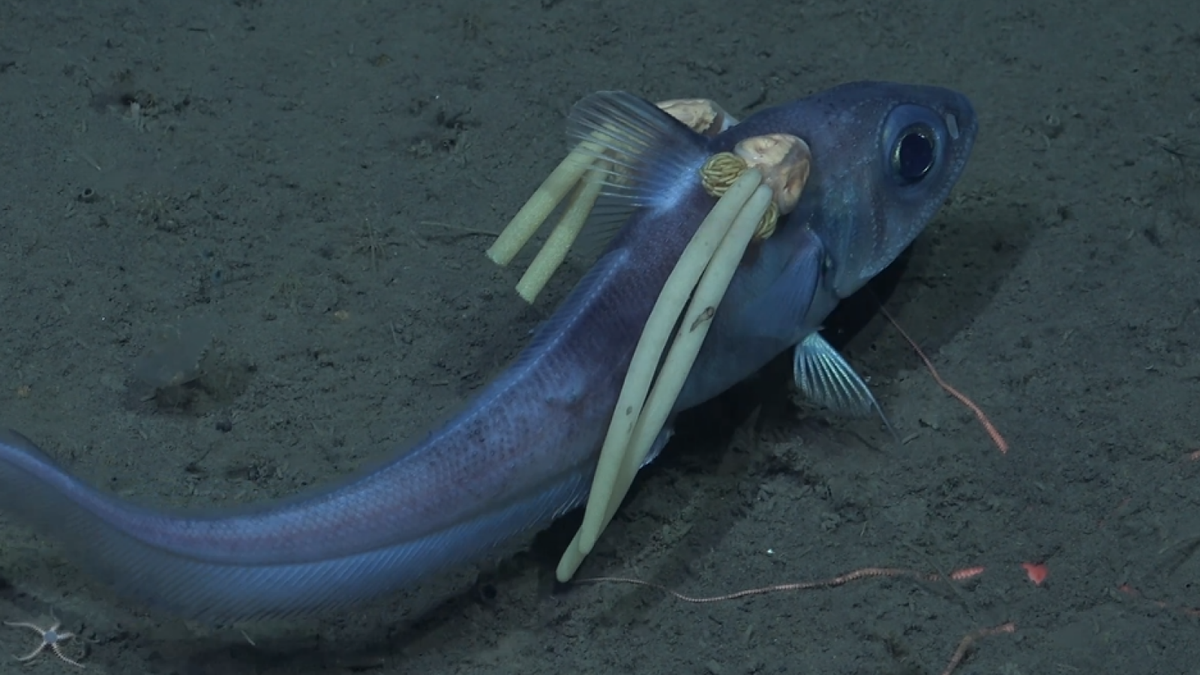Underwater parasites caught on camera vampirizing a deep-sea fish 👀
Follow us on Google News (click on ☆)
The video, captured at a depth of 489 meters (about 1,600 feet) near the South Sandwich Islands, shows two copepods of the species Lophoura szidati clinging to a fish of the Macrourus genus. These parasites, equipped with egg sacs, give the fish an unusual appearance with what looks like tufts.

A rattail fish filmed near the South Sandwich Islands with parasites attached to its head. Watch the video.
Credit: Schmidt Ocean Institute
The Macrourus, also known as grenadiers, inhabit the cold waters of the Atlantic and Antarctic. They live between 400 and 3,185 meters (1,300–10,450 feet) deep, a habitat where parasites like L. szidati are common but poorly studied.
The females of this species pierce the fish's skin to feed on their muscle tissues. Their life cycle includes several stages, starting with a larval phase where they burrow into their host's skin.
The copepods carry sacs containing hundreds of eggs, which they keep attached to their bodies until hatching. Once released, the larvae seek out a host of their own to continue their development.
Little is known about the lifespan of these parasites, but they remain attached to their host for several months. Even after their death, traces of their presence persist in the fish's tissues.
This discovery highlights the importance of research on deep-sea ecosystems. Host-parasite interactions like these play a crucial role in ocean biodiversity.
How do parasitic copepods infect their hosts?
Parasitic copepods begin their life cycle as microscopic larvae. These larvae swim freely until they find a suitable host, often a deep-sea fish.
Once in contact with the host, the larvae burrow into its skin. They then metamorphose, developing specialized structures to firmly attach and feed on their host's tissues.
Over time, the parasites grow and can produce hundreds of eggs. These eggs are carried in sacs attached to the parasite's body until they hatch.
This process demonstrates the remarkable adaptation of these organisms to a parasitic lifestyle, exploiting their hosts to survive and reproduce in the harsh deep-sea environment.
What is the impact of parasites on deep-sea fish?
Parasites like Lophoura szidati can affect the health and behavior of their hosts. By feeding on their tissues and fluids, they may weaken infected fish.
Despite this, many deep-sea fish coexist with these parasites without showing obvious signs of distress. This suggests a relationship where host and parasite may reach a certain balance.
Scars and damaged tissues caused by parasites can persist long after their death. These marks provide scientists with clues about past parasite-host interactions.
Understanding these dynamics is essential for assessing the health of deep-sea ecosystems and the biodiversity they support.